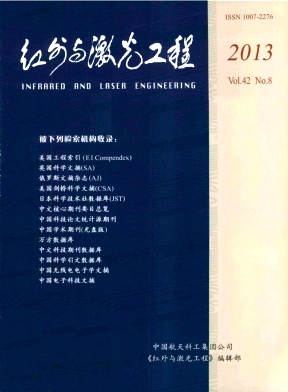|
[1]
|
Chen Xiuhong, Wei Heli, Xu Qingshan. Infrared atomospheric transmittance calculation model[J]. Infrared and Laser Engineering, 2011, 40(5): 811-816. (in Chinese) |
|
[2]
|
Fu Wei. Principle and application technology of IR stealth[J]. Infrared and Laser Engineering, 2002, 31(1): 88-93. (in Chinese) |
|
[3]
|
Bao Shi, Gu Wenhui, Zhang Xiaoguang. Infrared and radar composite stealth technology[J]. Electro-optic Technology Application, 2009, 24(4): 29-31. (in Chinese) |
|
[4]
|
Patel Rakesh P, Purohit Nirav S, Suthar Ajay M. An overview of silica aerogels[J]. Int J Chem Tech Res, 2009, 1(4): 1052-1057. |
|
[5]
|
Vincent Rocher, Kelly Stephen M, Hector Andrew L. Silicon imidonitride aerogel exhibiting macro-and meso-dual porosity[J]. Microporous and Mesoporous Materials, 2012, 156: 196-201. |
|
[6]
|
Prakash Sai S, Brinker C Jeffrey, Hurd Alan J. Silica aerogel films at ambient pressure[J]. Journal of Non-Crystalline Solids, 1995, 190(3): 264-275. |
|
[7]
|
Yokogawa H, Yokoyama M. Hydrophobic silica aerogels[J]. Journal of Non-Crystalline Solids, 1995, 186: 23-29. |
|
[8]
|
Zhao Junfeng, Chen Jianhua. Research progress of the infrared absorbing nano-materials[J]. New Chemical Materials, 2009, 37(7): 8-9. (in Chinese) |
|
[9]
|
Dai Songtao, Zhang Guangyan, Zhang Cunzhou. Hole digging mechanism of solid reflection spectrum-exploration of mech-anisms for infrared wave-absorbing materials(Ⅲ)[J]. Journal of Infrared and Millimeter Waves, 1997, 16(2): 46-49. (in Chinese) |
|
[10]
|
Child M J, Heywood M J, Pulton S K, et al. Infrared studies of the adsorption of triethylamine on silica at the solid/vapor and solid/liquid interfaces[J]. Journal of Colloid and Interface Science, 1982, 89(1): 202-208. |
|
[11]
|
Ryan Joseph V, Berry Alan D, Anderson Michele L, et al. Electronic connection to the interior of a mesoporous insulator with nanowires of crystalline RuO2[J]. Nature, 2000, 406: 169-172. |
|
[12]
|
Morris Catherine A, Anderson Michele L, Stroud Rhonda M, et al. Silica sol as a nanoglue: flexible synthesis of composite aerogels[J]. Science, 1999, 284: 622-624. |
|
[13]
|
Brunauer S, Deming L S, Deming W E, et al. On a theory of the van der waals adsorption of gases[J]. Journal of the American Chemical Society, 1940, 62(7): 1723-1732. |
|
[14]
|
Sing K S W. Reporting physisorption data for gas/solid systems[J]. Pure & Appl Chem, 1982, 54: 2201-2218. |
|
[15]
|
Fei Shi, Wang Lijiu, Jing Xiaoliu. Synthesis and characterization of silica aerogels by a novel fast ambient pressure drying process[J]. Materials Letters, 2006, 60(29-30): 3718-3722 |
|
[16]
|
Deng Qinying, Liu Lan, Deng Huimin. The Tutorial of Spectrum Analysis[M]. Beijing: Science Press, 2007. (in Chinese) |
|
[17]
|
Nakanishi K, Solomon Philippa H. Infrared Absorption Spectroscopy[M]. 2nd ed. US: Emerson-Adams Press, 1977. |
|
[18]
|
Bao Lixia, Qiao Xiaojing, Li Wangchang, et al. IR interference performance of carbon/ferromagnet composite materials[J]. Infrared and Laser Engineering, 2001, 40(8): 1416-1419. (in Chinese) |
|
[19]
|
Young Geunkwon, Se Youngchoi, Eul Sonkang. et al. Ambient-dried silica aerogel doped with TiO2 powder for thermal insulation[J]. Journal of Materials Science, 2000, 35: 6075-6079. |
|
[20]
|
Basila Michael R. Hydrogen bonding interaction between ads-orbate molecules and surface hydroxyl groups on silica[J].The Journal of Chemical Physics, 1961, 35: 1151-1158. |
|
[21]
|
Vancauwelaert F H, Vermoortele F, Uytterhoeven J B. Infrared spectroscopic study of the adsorption of amines on the a-type and b-type hydroxyls of an aerosil silica gel[J]. Discussions of the Faraday Society, 1971, 52: 66-76. |
|
[22]
|
Rochester Colin H, Geok Huayong. Infrared study of the adsorption of amines on silica immersed in carbon tetrachloride[J]. J Chem Soc Faraday Transl, 1980, 76: 1158-116. |









 DownLoad:
DownLoad: